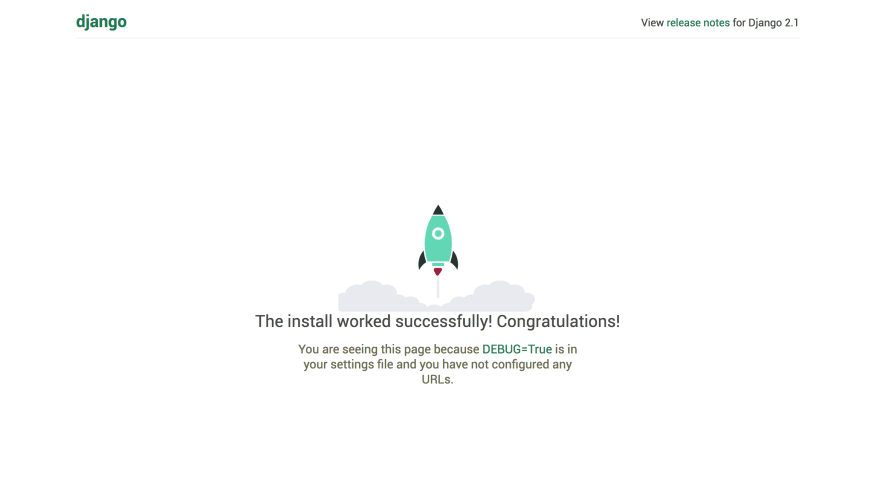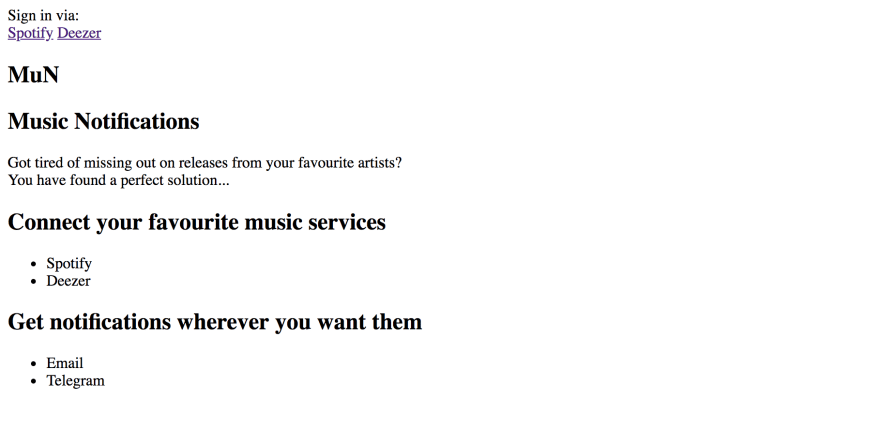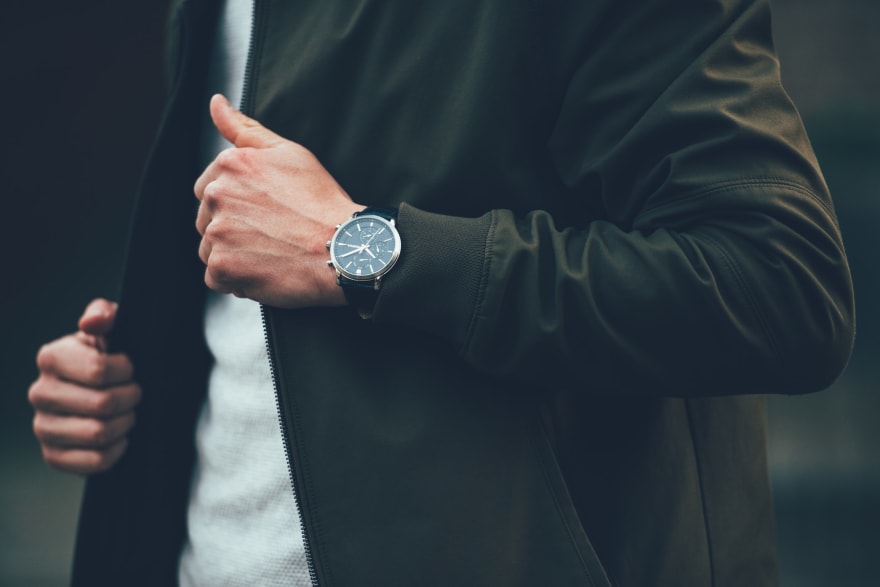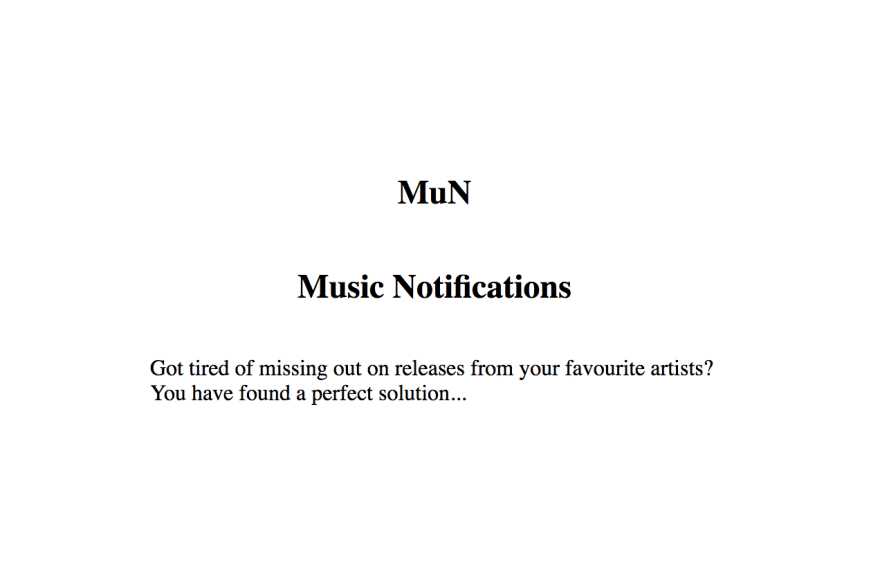In this tutorial we will create a landing page for a music releases notifications application in Django. To begin, we need to create a Django project.
Creating a Django project
I will assume you have Django installed but in case you don't, you can use the official installation guide.
To create a project run the following command in your terminal
django-admin startproject mun
And after the project is created go to its directory via cd command
cd /mun
And starting a server is as simple as
python manage.py runserver
After visiting 127.0.0.1:8000 you should see a screen that everything is great...
Except it's not your landing page...
Where do we start?
To add a landing page we need to create an "app" which is a Django concept for things that are not coupled to your app and can be extracted from it (for example authentication which can be used in other applications too).
But let's not get into that too much and just create a simple app called "pages" which will only contain static pages like "landing", "contact us" and "about".
python manage.py startapp pages
When the app is ready, we need to add it to Django's INSTALLED_APPS. We'll Just append our app to the end of those other ones because we're going to need some of those.
INSTALLED_APPS = [
'django.contrib.admin',
'django.contrib.auth',
'django.contrib.contenttypes',
'django.contrib.sessions',
'django.contrib.messages',
'django.contrib.staticfiles',
'pages',
]
The newly created pages app has a new pages folder with a couple of python files. Particular ones that interest us are pages/urls.py and pages/views.py.
URLs
When a request comes to the server, Django has to find a "view", a function that will process the request and send the response. The way Django finds how to connect a URL that came with the request and a view is via urlpatterns which are located in your project's main directory. In my case, it's mun/urls.py.
In order to show our landing page on 127.0.0.1:8000 and essentially on our main domain we need to add the following code to pages/urls.py
from django.urls import path
from . import views
urlpatterns = [
path('', views.index, name='index'),
]
A path is what comes after a domain in a URL. For example, in the URL https://www.google.com/search?q=mun the path would be /search?q=mun. Since we want our landing page to be on the / path the first parameter we provide to the path method is ''. The second argument is what view we need to render which is an index view in our case.
We also need to add urlpatterns from our app to the main project's urlpatterns with a built-in function include
from django.contrib import admin
from django.urls import include, path
urlpatterns = [
path('', include('pages.urls')),
path('admin/', admin.site.urls),
]
The view
If you recall, the index view is not yet created so let's go ahead and create it in pages/views.py
from django.shortcuts import render
def index(request):
return render(request, 'pages/index.html')
Our index action simply renders a 'pages/index.html' template which is again, not yet created. So let's create it.
The template
I want the landing page to contain the project's name, a brief description and a list of features.
First, let's start with the header. Our sign in buttons won't do anything right now so their href is # (which means it won't do anything) for now. We'll fix that in the next story.
<header class="header">
<div class="header-text">Sign in via:</div>
<a href="#" class="header-link">Spotify</a>
<a href="#" class="header-link">Deezer</a>
</header>
Second, let's add the brand name and a description
<section class="landing-section landing-main">
<h1 class="brand">MuN</h1>
<h2>
<span class="brand-text">Mu</span>sic
<span class="brand-text">N</span>otifications
</h2>
<p class="landing-main-text">
Got tired of missing out on releases from your favourite artists?
<br>
You have found a perfect solution...
</p>
</section>
Third, a list of features:
<section class="landing-section langing-features">
<section class="landing-feature feature-music-services">
<h2>Connect your favourite <span class="brand-text">mu</span>sic services</h2>
<ul>
<li>Spotify</li>
<li>Deezer</li>
</ul>
</section>
<section class="landing-feature feature-notifications">
<h2>Get <span class="brand-text">n</span>otifications wherever you want them</h2>
<ul>
<li>Email</li>
<li>Telegram</li>
</ul>
</section>
</section>
However, if we check our browser now we'll see a not so pleasant picture:
A CSS is a static file
To add CSS to the template Django has a whole app called django.contrib.staticfiles. By default , Django looks for static files in static folders of all apps. To add styles to the template we need to tell Django that we're going to use static files and add a stylesheet tag like so:
{% load static %}
<link rel="stylesheet" type="text/css" href="{% static 'pages/style.css' %}">
We'll also need the following line so that our page looks good on mobile
<meta name="viewport" content="width=device-width, initial-scale=1">
And while we're at it, let's add a title for our page
<title>MuN: Music Notifications</title>
Here's the full code glued together:
{% load static %}
<title>MuN: Music Notifications</title>
<meta name="viewport" content="width=device-width, initial-scale=1">
<link rel="stylesheet" type="text/css" href="{% static 'pages/style.css' %}">
<header class="header">
<div class="header-text">Sign in via:</div>
<a href="#" class="header-link">Spotify</a>
<a href="#" class="header-link">Deezer</a>
</header>
<section class="landing-section landing-main">
<div class="landing-section-content">
<h1 class="brand">MuN</h1>
<h2>
<span class="brand-text">Mu</span>sic
<span class="brand-text">N</span>otifications
</h2>
<p class="landing-main-text">
Got tired of missing out on releases from your favourite artists?
<br>
You have found a perfect solution...
</p>
</div>
</section>
<section class="landing-section langing-features">
<section class="landing-feature feature-music-services">
<h2>Connect your favourite <span class="brand-text">mu</span>sic services</h2>
<ul>
<li>Spotify</li>
<li>Deezer</li>
</ul>
</section>
<section class="landing-feature feature-notifications">
<h2>Get <span class="brand-text">n</span>otifications wherever you want them</h2>
<ul>
<li>Email</li>
<li>Telegram</li>
</ul>
</section>
</section>
Adding some style
To begin with, I would like to have a full-screen picture in the background with the project's name and the description in the middle.
We can do the text in the middle with the flexbox. First, we need to make our landing-section container width and height to full screen. CSS has a special unit for that: viewport height (or vh) and viewport width (or vw). If we set them both to 100 it would take the whole screen (or viewport).
However, if we have too much content and the screen is too small (a mobile phone for example) then we'd need to show more content than 100vh. We can use min-height instead of height for that.
.landing-section {
min-height: 100vh;
width: 100vw;
}
Now that we have our container take up the full screen we can position the content in the center with the flexbox. First of all, we need to set display: flex to use flexbox. Then we can use align-items: center and justify-content: center to position the content in the center.
There is only one problem left which is the direction of the content. The fix for it is pretty strait-forward — adding flex-direction: column.
For more flexbox, I recommend reading this guide.
Here's how our final landing-section class looks like
.landing-section {
min-height: 100vh;
width: 100vw;
display: flex;
align-items: center;
justify-content: center;
flex-direction: column;
}
The image in the background
I've used Unsplash to find the image that would fit my preference.
I set the image as a background with a little help of CSS-Tricks.
.landing-main {
background: url(https://images.unsplash.com/photo-1460667262436-cf19894f4774) no-repeat center center fixed;
background-size: cover;
}
However, the image has light and dark colors and I couldn't use neither black nor white colors over it. So I decided to add a little overlay and make the text white (or rather light-grey because white is too strong).
.landing-section-content {
padding: 2rem;
background: rgba(0,0,0,0.5);
width: 100vw;
display: flex;
align-items: center;
justify-content: center;
flex-direction: column;
color: #ccc;
}
.brand {
margin: 0;
color: #c55e00;
}
.brand-text {
color: #c55e00;
}
And a bit of styling for the header...
.header {
width: 100vw;
display: flex;
justify-content: flex-end;
top: 0;
left: 0;
position: absolute;
background: rgba(0,0,0,0.5);
}
.header-link {
margin: 1rem;
border-bottom: 3px solid #c55e00;
font-size: 1.2rem;
color: #222;
text-decoration: none;
color: #ccc;
}
.header-text {
margin: 1rem;
font-size: 1.2rem;
color: #ccc;
}
And here's what I got:
If you have any ideas for the features part, please, write them in the comments because it currently looks pretty awful.
One more thing
We've got most things done by now, however, there is one more. It's the icon. I like LogoMark website for this purpose. It is very simple to use and has a lot of beautiful icons and stuff.
When you download the icon, it gets saved in .png extension but .ico is better for an icon. ICOConverter is a great website for it.
After you download the icon in .icon extension, just copy it to the pages/static folder of your project and add 1 line to the index.html template:
<link rel="shortcut icon" href="{% static 'favicon.ico' %}"/>
Conclusion
In this story I’ve covered:
- how to create a Django project
- Django's apps concept
- how Django uses
urlpatternsto find your view - how to write HTML for your landing page
- how to style your landing page so that it looks good
- and the cherry on top of the cake — your icon
This is the first part of the series of articles about the MuN. Stay tuned for part 2. You can find the code of this project, as well as my other projects, on my GitHub page. If you liked this article you can follow me and if you didn’t — you can leave an angry comment down below.















Latest comments (3)
First Django tutorial I actually understand.
Thank you!
Great tutorial! This might confuse other newbies,
"To add a landing page we need to create an "app" which is a Django concept for things that are not coupled to your app and can be extracted from it"
should be
"To add a landing page we need to create an "app" which is a Django concept for things that are not coupled to your project and can be extracted from it"
I think :)
I loved this tutorial, im newbie un Django and this helped me a looot